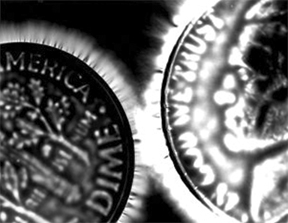KIRLIAN PHOTOGRAPHY
A Brief Look at Electro-Photography
by Joelle Steele
 Kirlian photography is a name applied to the electro-photographic process which was first attributed to the work of 18th century German physicist Georg Christoph Lichtenberg. In addition to discovering the basic principles of our modern-day photocopying process, Lichtenberg also used electricity to record tree-like patterns in fixed dust, figures which we today call fractals.
Kirlian photography is a name applied to the electro-photographic process which was first attributed to the work of 18th century German physicist Georg Christoph Lichtenberg. In addition to discovering the basic principles of our modern-day photocopying process, Lichtenberg also used electricity to record tree-like patterns in fixed dust, figures which we today call fractals.
In the late 19th century, Serbo-Croatian physicist and inventor extraordinaire Nicola Tesla used his famous Tesla coil to photograph corona discharges. In the early 20th century, Dr. F.F. Strong of Tufts University used the Tesla coil to make electro-photographs of his hand while Russian researcher Yakov Narkevich-Todka's electro-photography was first exhibited to the public.
It was not until the late 1930s that Semyon Davidovich Kirlian and his wife Valentina began their experiments with the process that now bears their name. For more than 30 years, the Kirlians studied high-voltage photography and developed the equipment to do it.

Coins
ELECTRO-PHOTOGRAPHIC PROCESS
Kirlian photography is also called electrography, electrophotography, and corona discharge photography. It is essentially a very simple process that involves using high voltage and an electric field to reproduce an image onto a photographic plate. In this way, it is a type of "contact print" photography or "photogram" in which images are produced through direct contact with photosensitive film.
The film is placed on top of a discharge or film plate, the object being photographed is placed on top of the film, and high voltage is applied to the plate to expose the film. A corona discharge between the object and the plate – created by the electric field at the edges of the object –passes through the film and is recorded onto it. Exposures – the time during which the electrical impulse runs through the object being photographed – vary from as little as 1/1000 of a second to as long as a minute, although more commonly used speeds are 1/20 to 1/2 second.
The Tesla coil also produced a similar high voltage corona effect. There is also a similar connection between luminescence and radiation, in which a radiated object placed on top of film sensitive to radiation produces an image of the object. This process was adapted from the Kirlian process and is termed "radiation field photography."
AURA AND HALO EFFECTS
What distinguishes electro-photography from regular photography is that the images appear to have halos or auras of light around them, giving them a supernatural effect that has been much expounded upon by later 20th century parapsychologists such as Thelma Moss, who believed that the halos were the energy of the subjects in the photographs.
The aura or halo effect is often attributed to the "life force" of a living subject, but it is also seen in inanimate objects such as coins. This halo effect can be influenced by such physical factors as air pressure, voltage, exposure time, and humidity. It is best exemplified when a series of electro-photographs are made of a living thing, such as a flower, in which each successive image produces a change or degradation in the aura. However, since a plucked flower is dying and is therefore dehydrating or losing its moisture as it dies, this drying out would have a direct impact on the electrical conductivity of the flower at its petals' dying edges.
Kirlian photography should not be confused with "aura photography," in which no high voltage is used and the subject is not in direct contact with the film. While many people believe that living beings project an aura that is equivalent to an "astral body" or "spirit body," scientists know that all matter radiates and produces an electrical field, and the Kirlians believed that the auras and halos were merely the electrical characteristics of the subject being photographed.

